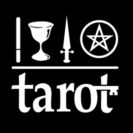Developing Elemental Pairing
All 78 Tarot cards are either Fire, Water, Air
or Earth. In itself, this does not tell you much, but you can combine
the four elements to create new energy forms. The rules for doing this
are very simple and easily to remember:
- Fire and Water are enemies and weaken each other
- Air and Earth are enemies and weaken each other
- Fire and Air are Active
- Water and Earth are Passive
Single Card Interpretation
The interpretation of an individual card is whatever the meaning you want it to have – usually in conformance with accepted meanings found in the many books on Tarot available. A single card does not influence another, nor is it influenced by others.
Pairing
The technique the Golden Dawn used was to “Pair” the two outer cards gradually working to the centre, “telling a story” that is developed at each stage. If there is an odd number of cards in the sequence you will be left with a solitary card at the centre, and it may have greater significance in the reading. When Pairing, the cards have equal strength, but with Elemental Dignities you can add another level of nuance.
The next question is what is this quality active or passive to? Obviously it has to be another card, but it will also be interacting with the original two.
Two Card Combinations
If you analyse the combinations, you will will find there are ten fixed permutations.
Note that you are not combining the “meanings”, only the energies. Throughout this essay we will keep up this outlook – feel free to insert your own cards in the elemental combinations described and see how you would interpret them.
As you can see, despite the rules of Elemental Dignities being defined mainly in terms of the enemy combinations, they are clearly in the minority. This is a very important point.
Reading Paired cards works best in a sequence, exemplified by the Golden Dawn method of Pairing.
Fire and Air are active and friendly to each other
Water and Earth are passive and friendly to each other
Fire and Earth are friendly and neutral to each other
Water and Air are friendly and neutral to each other
Fire and Fire are friendly with excess activity
Air and Air are friendly with excess mental activity
Water and Water are friendly with excess passivity
Earth and Earth are friendly excess passivity
Fire and Water are enemies, weak and neutral
Air and Earth are enemies, weak and neutral
Three Card Combinations
Each of the three cards has equal status, but the interaction between them reveals a subtler picture and a distinct change of emphasis that differs when you permute them. To make it easier for yourself, you take the centre card as the Principal, and the outer cards are Modifiers, but remember all three are interacting between themselves.
The Golden Rule in Elemental Dignities is to “analyse rigidly, but interpret flexibly”. The analysis of the energy flows will free your imagination from the fairly fixed interpretation of the individual cards. With experience you will begin to see visions that may or may not relate to the orthodox meanings of the individual cards, but will nevertheless be true.
The “Missing” Element
If you find yourself stuck in an interpretation, it is often worth considering what the missing element(s) would do if they were included.
Energy Blocks and Flows
Analysis of the three card combinations gives you the opportunity to see whether the energy is blocked, flows easily, is enhanced or diminished, or even transformed. You can see if the Subject (Principal) is supported by the Modifiers, or whether the Modifiers are working together or against themselves.
Reading Elemental Dignities in Positions
So far you have read Three cards in splendid isolation, but of course you know that life is not like that. You need a context or background, perhaps like the scenery we see when the curtain rises at the start of a play that establishes for the audience the time and place the actors are performing in. To do this, you place the three cards in an Elemental Position of Fire, Water, Air or Earth. As well as the circuit between the cards, they interact with the base element, which changes the emphasis. For example, a Fire card could be very strong in a three card spread, but it suddenly becomes very weak in a Water Position. By contrast, a weak Air card could be strengthened if it is in the Fire Position. Of course, the Elemental Position can give the “missing” element influence. A card that is reasonable and balanced suddenly becomes unbalanced and excessive by being placed upon its own Elemental Position. Actions that seemed a good idea can seem inappropriate, while any doubts are erased if the Elemental Position is supportive. The possibilities are endless, but it is still difficult to develop the situation we are trying to describe over time.
Since three cards are interpreted three different ways, and there are four elemental positions, you have twelve potential interpretations as far as Elemental Dignities are concerned. This is before you include the real Tarot card meanings! However, the power and flexibility of the Elemental Dignities have barely been scratched so far.
